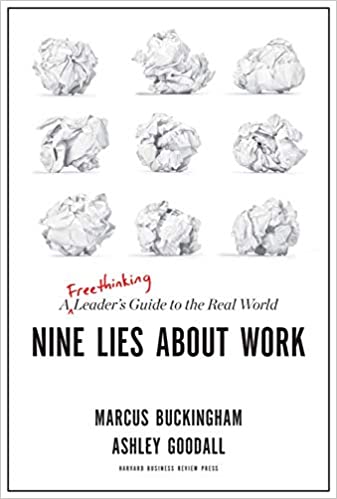This post is part of the 📖 Nine Lies About Work series.
Today, I am continue reading the LIE #4: The best people are well-rounded chapter of book Nine Lies About Work written by Authors Marcus Buckingham & Ashley Goodall.
There are some big lies, distortions, faulty assumptions, wrong thinking that we encounter every time we show up for work. Nine lies, to be exact. They cause dysfunction and frustration, ultimately resulting in workplaces that are a pale shadow of what they could be.
By reading Nine Lies About Work, you can get past the lies and discover what’s real. These freethinking leaders recognize the power and beauty of our uniqueness. They know that emergent patterns are more valuable than received wisdom and that evidence is more powerful than dogma.
Yesterday, I was reading the LIE #4: The best people are well-rounded chapter from Nine Lies About Work book.
Chapter #4
LIE #4: The best people are well-rounded
How do the best team leaders in the real world go about building great teams?
Here are three strategies we’ve seen used by the best team leaders.
- Get into the outcomes business
- Define the adjustable seat
- Use team technology
1. Get into the outcomes business:
As a team leader, you are in the outcomes business.
You are being paid to create specific outcomes for your company as efficiently, as predictably, and as sustainably as possible, and to do this with enough creativity and intuition and excitement to engage the sort of talent that you and your company will need tomorrow.
2. Define the adjustable seat
It entails adjusting the outcomes you’re asking individual team members to deliver to better match their distinctive talents.
The first strategy suggests that we clarify the outcomes we’re after and then help each team member find his or her path to these outcomes.
3. Use team technology
Well-roundedness is a misguided and futile objective for individual people, but it’s an absolute necessity for teams.
The more diverse the team members, the more weird, spiky, and idiosyncratic they are, the more well-rounded the team.
We should create a statement of collective values, priorities, purpose, and ambition. We should remove from our competency models the levels of ability, the individual evaluations, the feedback, and other things that they have become burdened.
Instead, we should simplify them, clarify them, recognize them (and name them) for what they are, and stick them on a wall for all to see.
Key Takeaways
- The competencies like Customer focus, innovation, growth orientation, agility — these are not abilities to be measured; they are values to be shared.
That’s it for today. Tomorrow, we will read the next chapter LIE #5: People need feedback.
LIE #1: People care which company they work for
We, as team members, want our team leader to make us feel part of something bigger, that he/she shows us how what we are doing together is important and meaningful. You as a team leader make us feel that you can see us, and connect to us, and care about us, and challenge us in a way that recognizes who we are as individuals.
LIE #2: The Best Plan Wins
It’s far better to coordinate your team’s efforts in real-time, relying heavily on each unique team member’s informed, detailed intelligence. You’ll have to sit down and survey your team members and make your plan.
The more frequently and predictably you check in with your people or meet with your team—the more you offer your real-time attention to the reality of their work—the more performance and engagement you will get.
It’s not true that the best plan wins. The best intelligence indeed wins.
LIE #3: The best companies cascade goals
We should unlock information through intelligence systems and cascade meaning through our expressed values, rituals, and stories.
We should let our people know what’s going on in the world and which hill we’re trying to take, and then we should trust them to figure out how to contribute.
They will invariably make better and more authentic decisions than those derived from any planning system that cascades goals from on high.
LIE #4: The best people are well-rounded
Best people are not well-rounded. They are distinctive. Well-roundedness is a misguided and futile objective for individual people, but it’s an absolute necessity for teams.
The well-rounded high performer is a creature of the theory world. However, each high performer is unique and distinct in the real world and excels precisely because that person has understood their uniqueness and cultivated it intelligently.
Competencies like Customer focus, innovation, growth orientation, agility are values to be shared, and they are not abilities to be measured.
Shift your thinking to outcomes where you’re asking individual team members to deliver to better match their distinctive talents.
Author(s): Marcus Buckingham
Author(s): Ashley Goodall
Part 10 of 23 in the 📖 Nine Lies About Work book series.
Series Start | Nine Lies About Work - Day 9 | Nine Lies About Work - Day 11
